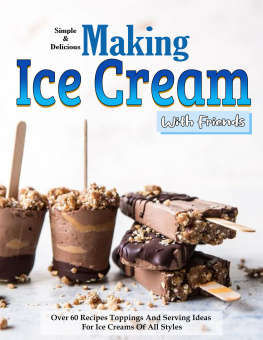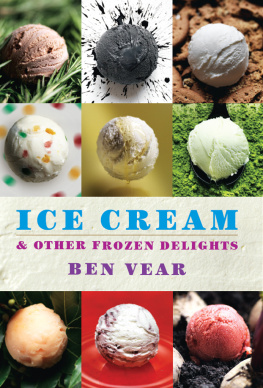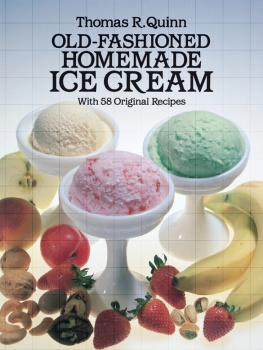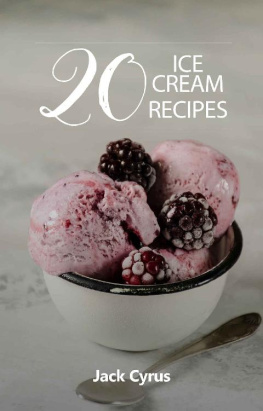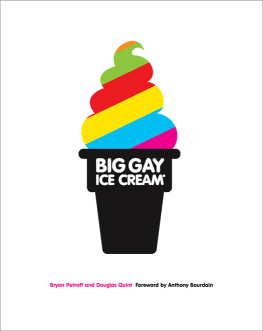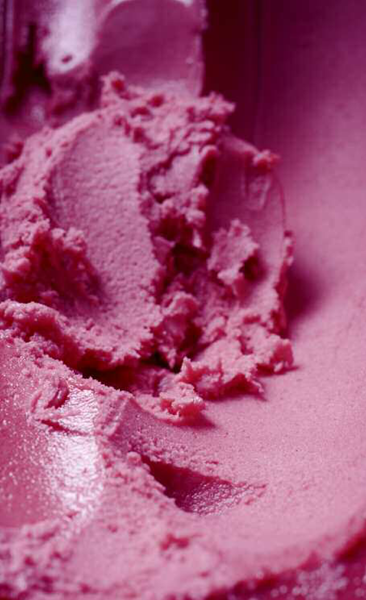Introduction:
Everyone Loves Ice Cream

I scream, you scream,
we all scream for ice cream!
Howard Johnson, Billy Moll and Robert King, 1927
Its called gelato in Italy, glace in France and morozhenoe in Russia. From Tokyo to Turin, from Denver to Delhi, everyone loves ice cream. With the possible exception of romance Your love is better than ice cream, singer Sarah McLachlan has crooned there are few of lifes pleasures, culinary or otherwise, that can match ice creams potent allure.
What accounts for the sweet frozen treats irresistible appeal?
First, ice cream is just plain delectable. Composed of cream or milk, sweeteners and flavourings, which are churned and frozen, ice cream boasts an icy sumptuousness. Whats more, ice cream packs an emotional wallop. Stoking the pleasure-producing regions of the brain, ice cream is known for its ability to generate feelings of well-being. Its amazing how quickly you recover from misery when someone offers you ice cream, marvelled teenager Eugene Jerome in Brighton Beach Memoirs, American playwright Neil Simons coming-of-age play.
Of course, ice cream tantalizes the taste buds and delights the eye. Theres the frothy ice cream soda sipped through a straw at the neighbourhood soda fountain. Theres the luxurious taste of a gelato-topped cone, relished while strolling through the streets of Rome. There are the Indian kulfiwalas hawking cardamom-perfumed kulfi on the streets of Delhi and Mumbai. Theres melting hot fudge enrobing a scoop of vanilla ice cream in a decadent pairing of heat and cold that rarely fails to thrill children and adults alike.
But ice cream also conjures up powerful memories sounds recalled from childhood or distinctive events, such as birthdays or patriotic celebrations. One of the measures of ice creams potent appeal is how the mere sight of the sweet, frozen confection immediately taps into memories of carefree childhood idylls, not to mention the innocence of simpler times. Theres the merry call of the ice cream man trolling city streets in a boxy white truck in New York or on a bicycle in Saigon and his promise of carefree summer days. (My own earliest ice cream memories are bittersweet. Hobbled by a dairy allergy, it was only at age four that I finally got to sample the frozen dessert. It was vanilla and it was simply the most heavenly food I had ever tasted.)
As befits a food so strongly identified with fun, the story of ice cream is a lively one. Its a moveable feast peppered with Chinese emperors and English kings, former slaves, women inventors, shrewd businessmen, Italian immigrant hokey pokey ice cream vendors, a gourmand First Lady, health food advocates, temperance apostles and modern-day food snobs.
Ice cream at various points in its history, its been called ices, iced-cream and cream began its ascent to worldwide dessert fame as a luxury food that only the upper crust could afford. As ice cream travelled through history, itevolved from a food identified with an opulent lifestyle into a mainstream consumer sensation coveted by paupers and princes alike.
Though the Chinese are said to have been the first to fashion a dairy-like frozen dessert, ice cream as we now know it was initially formulated in Europe, principally in Italy, but also in France, England and other parts of the Continent. Ice cream then travelled across the Atlantic to America. In fact, Americans like to claim ice cream as their national dessert, conferring upon it a status rivalling the mythic apple pie. Its true that American entrepreneurs and culinary inventors did contribute mightily to ice creams meteoric rise on to the world food stage. Worldwide favourites like the cone, the sundae and the soda were either created or popularized in the US. Whats more, the soda fountain is an American icon, and the commercial ice cream industry was also spawned and nurtured by US business and culinary talent. In fact, manyof todays most recognized global ice cream brands, such as Hagen-Dazs and Baskin-Robbins, claim American roots.
Yet without culinary influences from the Old World, ice cream in the US would never have evolved into the global mass-market phenomenon it eventually became. Early Italian, French and English confectioners created ice cream recipes and techniques that spawned the modern ice cream that we cherish today. Italian immigrants spread the art of ice cream making throughout Europe and North America. There, they sold their wares on the streets of New York, London, Berlin and other cities, where they paved the way for ice cream to emerge as one of the worlds most beloved street foods.
Despite the sizeable American influence, indigenous ice cream cultures flourish worldwide. For example, Italian gelato is prized by ice cream connoisseurs everywhere. In Turkey and parts of the Middle East, salepi dondurma, an ice cream enhanced with orchid root, continues to flourish.
Still today, national ice cream traditions are fading, blending into a universal version of what once was a distinctive local dessert. In fact, ice cream has been transformed into a culinary blank slate which can take on the colouration of just about any food culture. A Long Island, New York ice cream maker produces kulfi using a pre-mixed American ice cream base. In Brooklyn, a group of women express their Eastern European Jewish culinary roots through ice cream. Matzoh Crunch, anyone?









